A Distinct and Genetically Isolated Polar Bear Population Found in Southeast Greenland
Scientists have studied and monitored the polar bears identified as surviving despite limited access to the ocean ice—a crucial factor for cold-region animals. Instead, these bears have utilized freshwater ice from Greenland’s ice sheet.
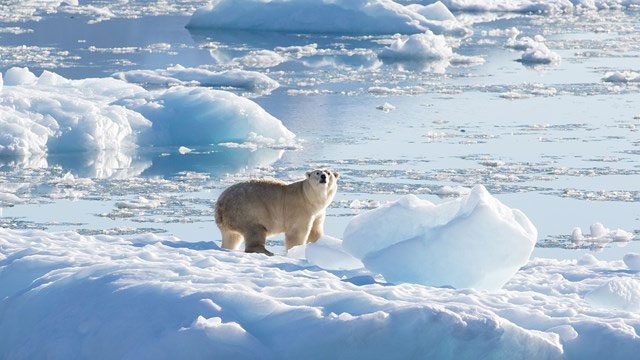
A polar bear in Southeast Greenland, September 2016. (Photo: CNN).
“We wanted to survey this area because we know little about the polar bears in Southeast Greenland, but the researchers never expected to find a newly surviving population there,” said lead author Kristin Laidre, a polar science researcher at the University of Washington’s Applied Physics Laboratory, in a statement.
“We knew there were some bears in the area from historical records and indigenous knowledge. We just didn’t know how special they were.”
The Importance of Ice
Nineteen known polar bear populations rely on ocean ice to hunt prey, such as ringed seals, which often gather near ice holes to catch food. The calories provided by seals can help them store energy for months when food and ice are scarce.
Global warming is causing ice to melt rapidly, with the Arctic warming at twice the rate of the rest of the planet. As ice sheets disappear, polar bears are forced to move onto land, reducing their chances of finding food.

An adult female polar bear (left) and two one-year-old cubs walking on a glacier, March 2015. (Photo: CNN).
Meanwhile, polar bears in Southeast Greenland tend to live closer to home, adapting to their environment in unique ways. Despite being isolated by the Greenland ice sheet, mountains, and swift coastal currents, the polar bears here can still access freshwater ice, and a few can reach sea ice, which helps them catch seals.
The bears can utilize ice from February until the end of May. For the rest of the year, they hunt seals using freshwater ice as it breaks away from the larger ice sheets.
Laidre, an associate professor of aquatic and fishery sciences at the University of Washington, stated: “Polar bears are threatened by the melting of ocean ice due to climate change.”
“But we need to be cautious when extrapolating our findings because the ice at the glaciers that has allowed the Southeast Greenland bears to survive is not present in most of the Arctic.”
The environment in Southeast Greenland serves as a unique small-scale climate refuge where the species can survive, and similar habitats can be found along the coasts of Greenland and Norway’s Svalbard archipelago.
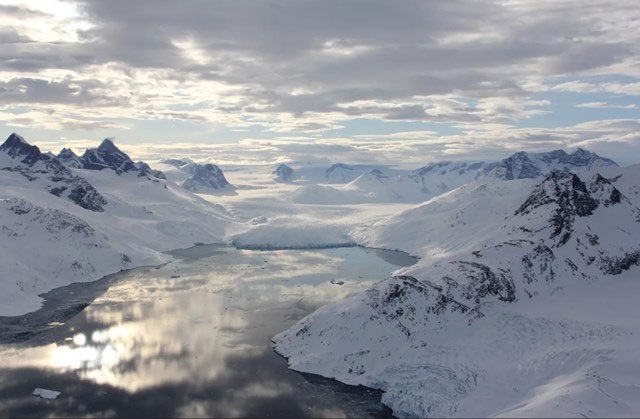
A fjord in Southeast Greenland filled with water, April 2016. (Photo: CNN).
“These types of glaciers do exist elsewhere outside the Arctic, but the combination of fjord shapes, high glacier output, and the large ice reserves available from Greenland currently provides a stable supply for glaciers,” said co-author Twila Moon, a deputy group leader at the U.S. National Snow and Ice Data Center in Boulder, Colorado, in a statement.
“In a sense, these bears have provided a glimpse into how Greenland bears might survive under future climate scenarios,” Laidre said. “The ice conditions in Southeast Greenland today are quite similar to what is predicted for Northeast Greenland by the end of this century.”
Aerial Research
The new study includes 30 years of historical data from the eastern coast of Greenland and seven years of new data from the southeastern coast.
The research team spent two years consulting with polar bear hunters, who hunt bears for survival rather than sport, in eastern Greenland. The hunters were able to share their expertise and contribute samples for genetic analysis.
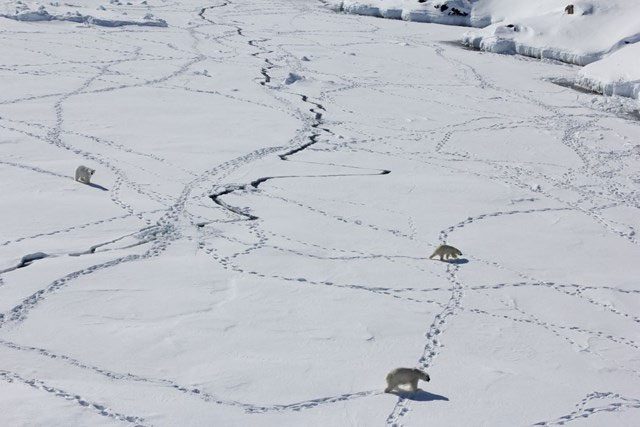
Three adult polar bears in Greenland, April 2015. (Photo: CNN).
The researchers collaborated with the Greenland Institute of Natural Resources in Nuuk, Greenland, to study and track the bears using helicopters, estimating that there are several hundred bears living in the remote area. This is similar to small polar bear populations in other regions.
Polar bears in Southeast Greenland are smaller than those in other regions. The smaller bears also have fewer cubs, which may be related to their search for mates as they traverse the fjords and surrounding mountains.
The bears either travel across the ice in the fjords or climb over mountains to reach neighboring fjords. Among the 27 bears tracked during the study, half of them accidentally drifted an average of about 190 km south, becoming stranded on small ice floes in the swift currents off the eastern coast of Greenland.
Once they have the opportunity, the bears simply jump off the ice and walk back to the fjord they call home. Fjords are deep, long, narrow sea inlets formed by glaciers found between tall cliffs.
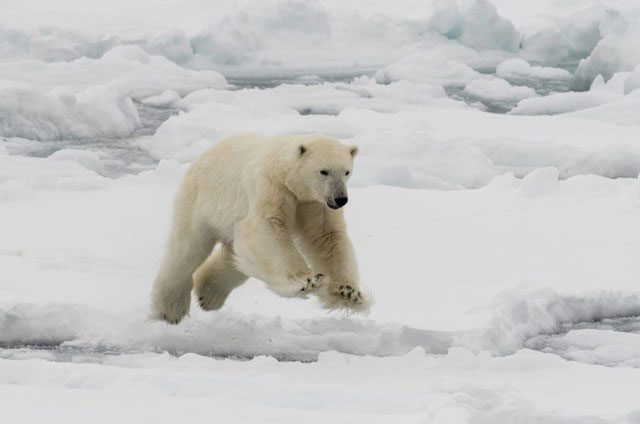
A polar bear’s leap. (Photo: CNN).
Moon stated: “Even as rapid changes occur on the ice, this area in Greenland still has the potential to continue producing glacial ice, and the coastline may remain intact as it is now for a long time.”
However, researchers warn that this habitat may not be sufficient for other polar bears after the climate crisis.
Laidre said: “If we are concerned about polar bear conservation, then yes, our findings are hopeful—I think we have seen how some polar bears can survive under climate change conditions.”
An Uncertain Future
Researchers believe that polar bears in Southeast Greenland have evolved in isolation for several hundred years. According to the study’s authors, the earliest known reference to bears in this location dates back to the 1300s, and the first records of the species in the area’s fjords are from the 1830s.
The status of the polar bears remains unclear. Researchers do not know whether the population is stable, increasing, or decreasing, but more monitoring could reveal the future for this unique population, Laidre said.
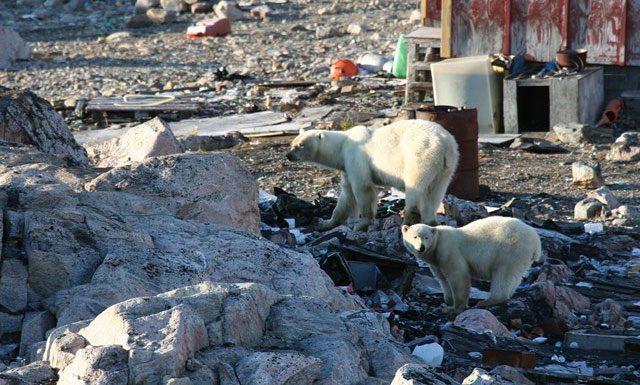
As ice sheets disappear, polar bears must move onto land, reducing their chances of finding food. (Photo: CNN).
Due to their isolation, these polar bears are genetically distinct enough that researchers propose the Southeast Greenland polar bears should be considered the 20th subpopulation of the species.
Laidre stated: “Conserving the genetic diversity of polar bears is critical under climate change conditions. Officially recognizing these bears as a separate population would have significant implications for conservation and management.”
Meanwhile, sea ice continues to melt in the Arctic, significantly reducing the survival rates of most polar bear populations in the future.
“Taking action on climate is the most important thing for the future of polar bears,” Laidre emphasized.





















































